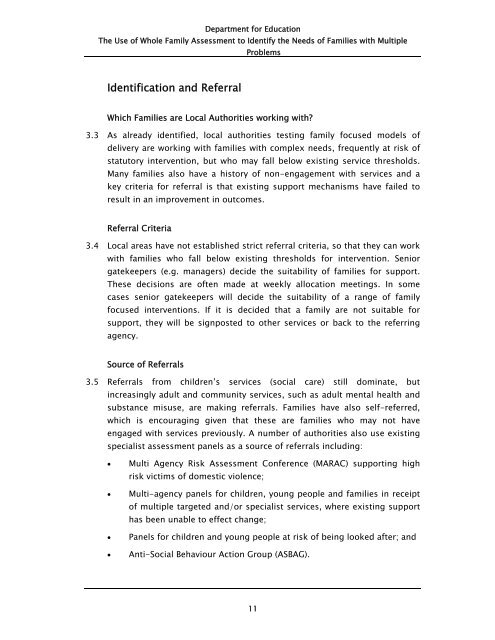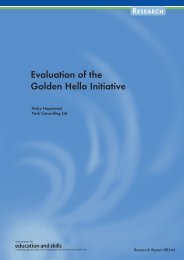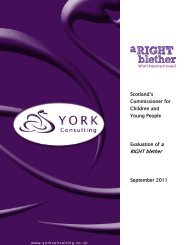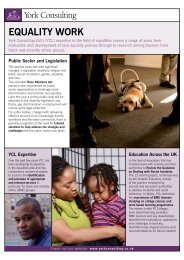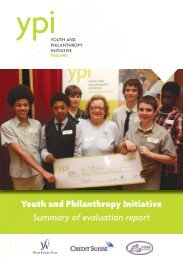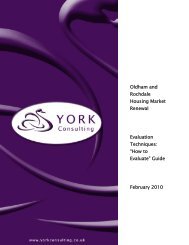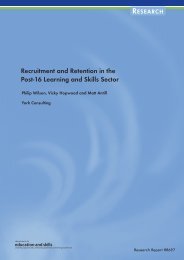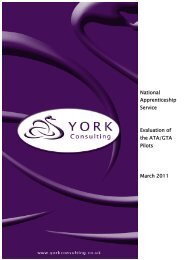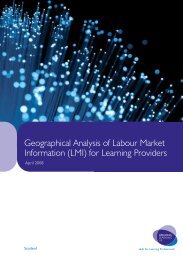The use of whole family assessment to identify the needs of families ...
The use of whole family assessment to identify the needs of families ...
The use of whole family assessment to identify the needs of families ...
Create successful ePaper yourself
Turn your PDF publications into a flip-book with our unique Google optimized e-Paper software.
Department for Education<strong>The</strong> Use <strong>of</strong> Whole Family Assessment <strong>to</strong> Identify <strong>the</strong> Needs <strong>of</strong> Families with MultipleProblemsIdentification and ReferralWhich Families are Local Authorities working with?3.3 As already identified, local authorities testing <strong>family</strong> foc<strong>use</strong>d models <strong>of</strong>delivery are working with <strong>families</strong> with complex <strong>needs</strong>, frequently at risk <strong>of</strong>statu<strong>to</strong>ry intervention, but who may fall below existing service thresholds.Many <strong>families</strong> also have a his<strong>to</strong>ry <strong>of</strong> non-engagement with services and akey criteria for referral is that existing support mechanisms have failed <strong>to</strong>result in an improvement in outcomes.Referral Criteria3.4 Local areas have not established strict referral criteria, so that <strong>the</strong>y can workwith <strong>families</strong> who fall below existing thresholds for intervention. Seniorgatekeepers (e.g. managers) decide <strong>the</strong> suitability <strong>of</strong> <strong>families</strong> for support.<strong>The</strong>se decisions are <strong>of</strong>ten made at weekly allocation meetings. In somecases senior gatekeepers will decide <strong>the</strong> suitability <strong>of</strong> a range <strong>of</strong> <strong>family</strong>foc<strong>use</strong>d interventions. If it is decided that a <strong>family</strong> are not suitable forsupport, <strong>the</strong>y will be signposted <strong>to</strong> o<strong>the</strong>r services or back <strong>to</strong> <strong>the</strong> referringagency.Source <strong>of</strong> Referrals3.5 Referrals from children’s services (social care) still dominate, butincreasingly adult and community services, such as adult mental health andsubstance mis<strong>use</strong>, are making referrals. Families have also self-referred,which is encouraging given that <strong>the</strong>se are <strong>families</strong> who may not haveengaged with services previously. A number <strong>of</strong> authorities also <strong>use</strong> existingspecialist <strong>assessment</strong> panels as a source <strong>of</strong> referrals including:Multi Agency Risk Assessment Conference (MARAC) supporting highrisk victims <strong>of</strong> domestic violence;Multi-agency panels for children, young people and <strong>families</strong> in receipt<strong>of</strong> multiple targeted and/or specialist services, where existing supporthas been unable <strong>to</strong> effect change;Panels for children and young people at risk <strong>of</strong> being looked after; andAnti-Social Behaviour Action Group (ASBAG).11


